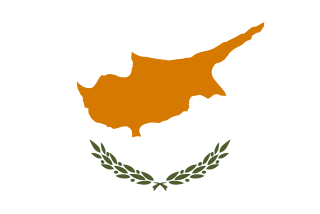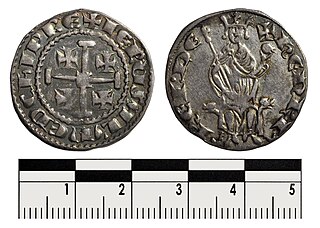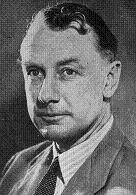
Cyprus, officially the Republic of Cyprus, is an island country in the eastern Mediterranean Sea south of the Anatolian Peninsula. It is the third-largest and third-most populous island in the Mediterranean, and is located south of Turkey, west of Syria, northwest of Lebanon, Israel, and the Gaza Strip (Palestine), north of Egypt, and southeast of Greece. Its capital and largest city is Nicosia.

Nicosia is the largest city, capital, and seat of government of Cyprus. It is located near the centre of the Mesaoria plain, on the banks of the River Pedieos.

Makarios III was a Greek Cypriot clergyman and politician who served as the archbishop and primate of the autocephalous Church of Cyprus (1950–1977) and as the first president of Cyprus (1960–1977). In his three terms as president he survived four assassination attempts and a coup d'état. He is widely regarded by Greek Cypriots as the Father of the Nation or "Ethnarch".

The Ethniki Organosis Kyprion Agoniston was a Greek Cypriot nationalist paramilitary organisation that fought a campaign for the end of British rule in Cyprus, and for eventual union with Greece.

Henry II was the last crowned King of Jerusalem and also ruled as King of Cyprus. He was of the Lusignan dynasty.
Polykarpos Giorkatzis was a Cypriot politician. He served as the first Minister of the Interior of the Republic of Cyprus. He also served as provisional minister of Labour in the period leading to Cyprus being proclaimed an independent state. Before entering the political stage he fought for EOKA. His political career evolved from a staunch supporter of Makarios to becoming one of the archbishop's principal political rivals. He was assassinated in 1970.

Georgios Grivas, also known by his nickname Digenis, was a Cypriot general in the Hellenic Army and the leader of the EOKA organisation.

This article is about the history of Cyprus from 1878 to the present.
Nikos Sampson was the de facto president of Cyprus who succeeded Archbishop Makarios, appointed as President of Cyprus by the Greek military leaders of the coup d'état against Makarios, on July 15, 1974. Sampson was a journalist and a member of EOKA, which rose against the British colonial administration, seeking Enosis (Union) of the island of Cyprus with Greece. He was eventually arrested and sentenced to death, but was imprisoned in Britain after the sentence was commuted, returning after Cyprus gained independence.

The Turkish invasion of Cyprus was launched on 20 July 1974, following the Cypriot coup d'état on 15 July 1974.
Amalric, Lord of Tyre, also called Amalric of Lusignan or Amaury de Lusignan was a prince and statesman of the House of Lusignan, a younger son of King Hugh III of Cyprus and Isabella of the House of Ibelin. He was given the title of Lord of Tyre in 1291, shortly before the city of Tyre fell to the Mamluks of Egypt. He is often but incorrectly called the Prince of Tyre.

Nicosia International Airport is a largely disused airport located 8.2 km (5.1 mi) west of the Cypriot capital city of Nicosia in the Lakatamia suburb. It was originally the main airport for the island, but commercial activity ceased following the Turkish invasion of Cyprus in 1974. The airport site is now mainly used as the headquarters of the United Nations Peacekeeping Force in Cyprus.

Vassos Lyssarides was a Cypriot politician and physician who was a central figure in the politics of Cyprus after the island's independence.

Armenians in Cyprus or Armenian-Cypriots are ethnic Armenians who live in Cyprus. They are a recognized minority with their own language, schools and churches. Despite the relatively small number of Armenians living in Cyprus, the Armenian-Cypriot community has had a significant impact upon the Armenian diaspora and Armenian people. During the Middle Ages, Cyprus had an extensive connection with the Armenian Kingdom of Cilicia, while the Ganchvor monastery had an important presence in Famagusta. During the Ottoman Era, the Virgin Mary church and the Magaravank were very prominent. Certain Armenian-Cypriots were or are very prominent on a Panarmenian or international level and the fact that, for nearly half a century, the survivors of the Armenian genocide have co-operated and co-existed peacefully with the Turkish-Cypriots is perhaps a unique phenomenon across the Armenian Diaspora. The emigration of a large number of Armenian-Cypriots to the United Kingdom has virtually shaped today's British-Armenian community.
Several distinct periods of Cypriot intercommunal violence involving the two main ethnic communities, Greek Cypriots and Turkish Cypriots, marked mid-20th century Cyprus. These included the Cyprus Emergency of 1955–59 during British rule, the post-independence Cyprus crisis of 1963–64, and the Cyprus crisis of 1967. Hostilities culminated in the 1974 de facto division of the island along the Green Line following the Turkish invasion of Cyprus. The region has been relatively peaceful since then, but the Cyprus dispute has continued, with various attempts to solve it diplomatically having been generally unsuccessful.

Sir Robert Perceval Armitage was a British colonial administrator who held senior positions in Kenya and the Gold Coast, and was Governor of Cyprus and then of Nyasaland during the period when the former British colonies were gaining independence.
The 1 April Attacks were a series of attacks across Cyprus in 1955 by the EOKA which led to the start of the Cyprus Emergency. Multiple British locations were attacked after midnight by EOKA members. This attack was accompanied by the distribution of leaflets across Cyprus.
The Police Station Attacks were a series of guerrilla style attacks by the EOKA on police stations in Cyprus during June 1955 which led to the start of the Cyprus Emergency. The attacks took place:











